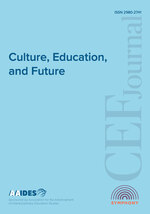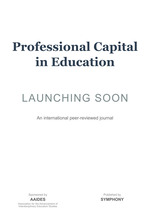Currere as Punctuated Manifestions
DOI:
https://doi.org/10.70116/3065457239Keywords:
Currere, manifestations, contingency, attunement and interiorityAbstract
Currere emphasizes individual experience and how one can learn from these experiences (Pinar, 2011). This paper explores how one’s individual experience (currere writing) affords “punctuated manifestations” in which one who is spatially and temporally embodied and entangled engages in a recursive helictical motion of transformation while wandering through various thresholds of understanding toward infinity and traversing between/across the imagined and unimaginable and beyond. In associating with ancient Chinese novels and certain ideas in Chinese Taoism, this paper illuminates the construction and reconstruction of layers of experience, which may contribute to an alternative way of understanding currere by highlighting currere as a method that embraces the endless fluidity of one’s experiences creating an infinite, yet subliminal myriad of intersectionalities, crossings, and synthesis. Such a currere of punctuated manifestations describes emanating intersectionalities of particularity and universality, lived crossings of subjectivity and contingency, entangled convergences of past, present, and future, orienting us toward our “interiority” (Doll, 2017, p. 96). Then, currere becomes a thriving centerpiece from which to extend, to punctuate, to attune. Unfolding through contingency, the punctuated manifestations of currere stress endlessly approaching one’s “interiority” while embedding oneself within expanding encounters with self and others.
Downloads
References
Ames, R. (1996). The classical Chinese self of hypocrisy. In R. T. Ames & W. Dissanayake (Eds.), Self and deception: A cross-cultural philosophical enquiry. State University of New York Press.
Casemore, B. (2019). Following the thread of life in Mary Aswell Doll’s The mythopoetics of currere. Journal of the American Association for the Advancement of Curriculum Studies, 13(2), 1–14.
Chang, C. (1963). Creativity and Taoism. Julian Press.
Clarke, J. (2000). The Tao of the West Western transformations of Taoist thought. Routledge.
Cooper, J. C. (1972). Taoism: The way of the mystic. Samuel Weiser.
Corner, J. (1999). Introduction: Mapping meaning. In Dennis Cosgrove (Ed.), Mappings (pp. 1-23). Reaction Books.
Cortazzi, M. (2014). Narrative analysis. Routledge. DOI: https://doi.org/10.4324/9781315067421
Doll, M. (2017). The mythopoetics of currere: Memories, dreams, and literary texts as teaching avenues to self-study. Routledge. DOI: https://doi.org/10.4324/9781315461366
Freiberg, J. (1975). The Taoist mind: A case study in a “structure of consciousness”. Sociological Analysis, 36(4), 304-322. DOI: https://doi.org/10.2307/3710519
Irwin, R. (2006). Walking to create an aesthetic and spiritual currere. Visual Arts Research, 32(1), 75-82.
Kroll, P. (1996). Body gods and inner vision: The scripture of the yellow court. In D. S. Lopez Jr. (Ed.), Religions of China in practice (pp. 149-155). Princeton University Press. DOI: https://doi.org/10.1515/9780691234601-015
McKnight, D. (2010). Critical Pedagogy and despair: A move toward Kierkegaard’ Passionate Inwardness. In E. Malewski (Ed.). Curriculum Studies Handbook: The next moment (pp. 500-507). Routledge.
Miller, J. L. (2010). Autobiographical theory. In C. Kridel (Ed.), Encyclopedia of curriculum studies (Vol. 1, pp. 61–65). Sage Publications.
Morris, M. (2015). Currere as subject matter. In M. F. He, B. D. Schultz, & W. H. Schubert (Eds.), The SAGE guide to curriculum in education (pp. 103-109). Sage. DOI: https://doi.org/10.4135/9781483346687.n17
Nakagawa, Y. (2008). Eastern wisdom and holistic education: Multidimensional reality and the way of awareness. In C. Eppert & H. Wang (Eds.), Cross-cultural studies in curriculum: Eastern thought, educational insights (pp. 227–245). Lawrence Erlbaum Associates.
Needham, J. (1956). Science and civilization in China. Cambridge University Press.
Pinar, W. (1975). The Analysis of Educational Experience. In W. F. Pinar (Ed.), Curriculum theorizing: The reconceptualists (pp. 384-395). McCutchan Publishing Corporation.
Pinar, W. (2011). What is curriculum theory? (2nd ed.). Routledge. DOI: https://doi.org/10.4324/9780203836033
Pinar, W. (2019). Currere. In J. Wearing, M. Ingersoll, C. DeLuca, B. Bolden, H. Ogden, T. C. Christou (Eds), Key concepts in curriculum studies-perspectives on the fundamentals ( pp. 50-52). Routledge. DOI: https://doi.org/10.4324/9781351167086-11
Pinar, W., Reynolds, W. M., Slattery, P., & Taubman, P. T. (1995). Understanding curriculum: An introduction to the study of historical and contemporary curriculum discourses. Peter Lang.
Pollock, D. (1998). Performative writing. In P. Phelan & J. Lane (Eds.), The ends of performance (pp. 73-103). New York University Press.
Robinet, I. (2011). The world upside down. Golden Elixir Press.
Sameshima, P., & Irwin, R. (2008). Rendering dimensions of liminal currere. Transnational Curriculum Inquiry, 5(2), 1-15.
Silverman, H., & Welton, D. (Eds.). (1988). Postmodernism and continental philosophy. State University of New York Press.
Stone, L. (2007). A review of Hongyu Wang, The call from the stranger on a journey home: Curriculum in a third space: Wang’s self-seeking subject in search of a third space. Studies in Philosophy and Education, 26(5), 377–387. DOI: https://doi.org/10.1007/s11217-007-9040-8
Wang, W. (2020). Chinese currere, subjective reconstruction and attunement—When calls my heart. Palgrave Macmillan. DOI: https://doi.org/10.1007/978-3-030-41061-2
Wang, W. (2022). Toward an understanding of curriculum as spiritual text. Educational Research & Development Journal, 25(2), 1-19.
Wilhelm, R. (1962). The secret of the golden flower. Harcourt Brace Jovanovich.
Downloads
Published
How to Cite
Issue
Section
License
Copyright (c) 2024 Symphony

This work is licensed under a Creative Commons Attribution 4.0 International License.










